Training Benefits: Iceland Food Case Study
VerifiedAdded on 2020/01/07
|71
|20083
|301
Thesis and Dissertation
AI Summary
This dissertation investigates the benefits of employee training and development, using Iceland Food Company as a case study. Employing a critical realist philosophy and inductive approach, the research utilizes both quantitative (survey of 150 employees) and qualitative (interviews with 10 managers) data collection methods. The findings reveal that training positively impacts employee attitudes towards performance, enhances employee engagement and motivation, and contributes to organizational success. The study identifies on-the-job training as a preferred method and highlights the importance of regular training sessions. Limitations include the sample size and potential biases in qualitative data. Recommendations include aligning training programs with employee needs and implementing regular on-the-job training sessions.
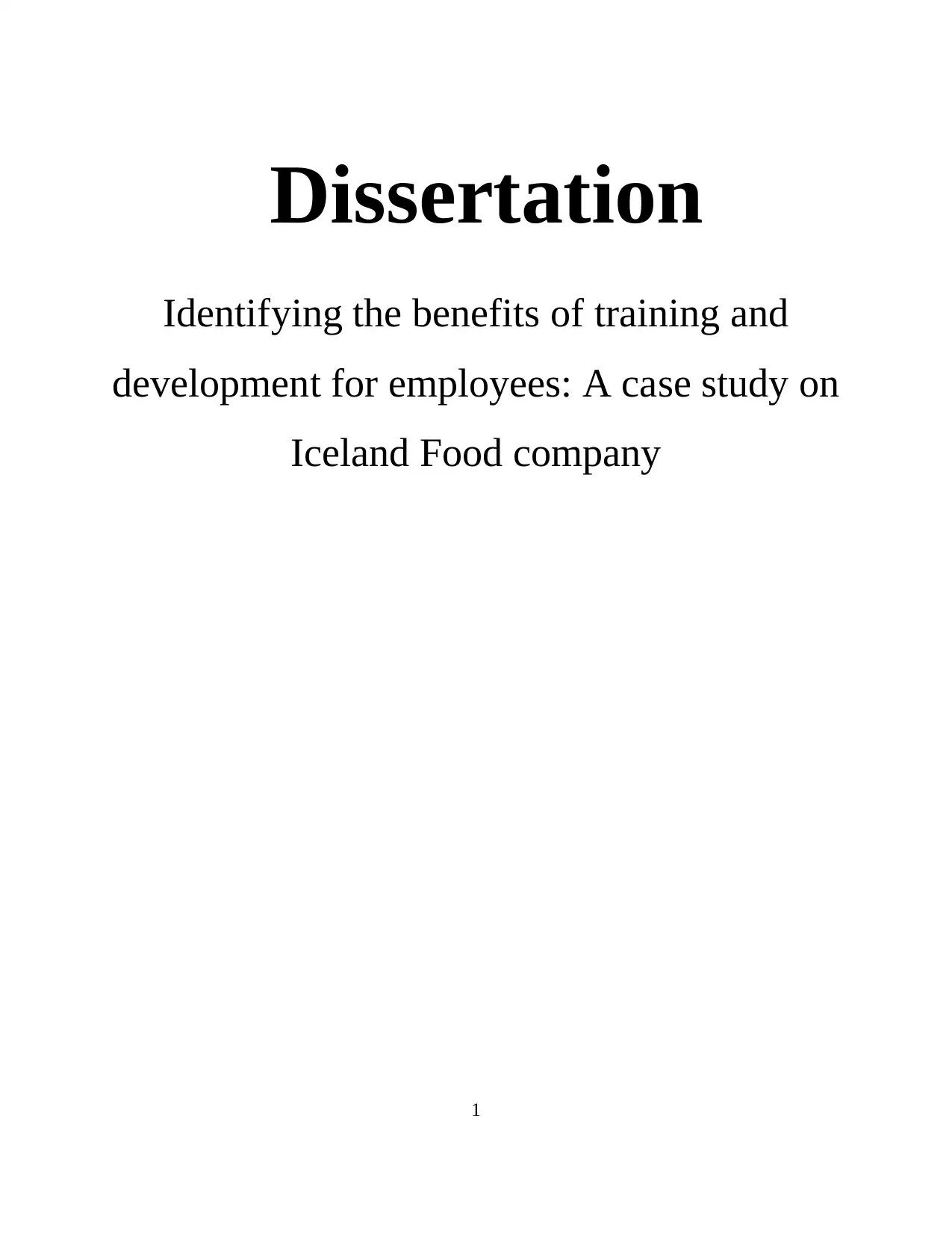
Dissertation
Identifying the benefits of training and
development for employees: A case study on
Iceland Food company
1
Identifying the benefits of training and
development for employees: A case study on
Iceland Food company
1
Paraphrase This Document
Need a fresh take? Get an instant paraphrase of this document with our AI Paraphraser

ACKNOWLEDGEMENT
There are so many people who supported me in preparing the study and I would like to
extend my thanks to all those people. I have acquired immense support from them during the
research work; hence because of all their support only it became possible for me to complete the
entire study. Hence, I am grateful to everyone who helped me in preparing this study.
2
There are so many people who supported me in preparing the study and I would like to
extend my thanks to all those people. I have acquired immense support from them during the
research work; hence because of all their support only it became possible for me to complete the
entire study. Hence, I am grateful to everyone who helped me in preparing this study.
2
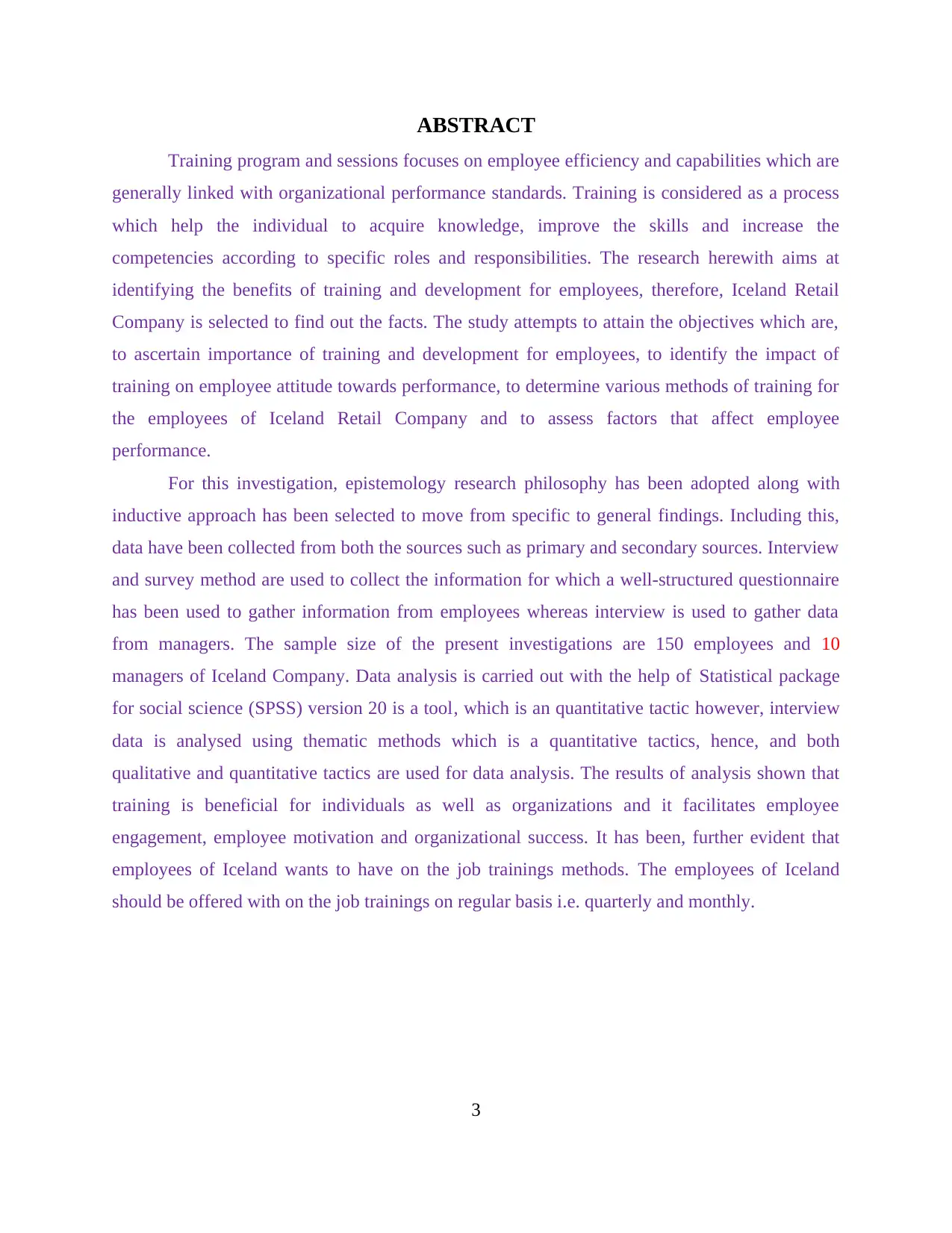
ABSTRACT
Training program and sessions focuses on employee efficiency and capabilities which are
generally linked with organizational performance standards. Training is considered as a process
which help the individual to acquire knowledge, improve the skills and increase the
competencies according to specific roles and responsibilities. The research herewith aims at
identifying the benefits of training and development for employees, therefore, Iceland Retail
Company is selected to find out the facts. The study attempts to attain the objectives which are,
to ascertain importance of training and development for employees, to identify the impact of
training on employee attitude towards performance, to determine various methods of training for
the employees of Iceland Retail Company and to assess factors that affect employee
performance.
For this investigation, epistemology research philosophy has been adopted along with
inductive approach has been selected to move from specific to general findings. Including this,
data have been collected from both the sources such as primary and secondary sources. Interview
and survey method are used to collect the information for which a well-structured questionnaire
has been used to gather information from employees whereas interview is used to gather data
from managers. The sample size of the present investigations are 150 employees and 10
managers of Iceland Company. Data analysis is carried out with the help of Statistical package
for social science (SPSS) version 20 is a tool, which is an quantitative tactic however, interview
data is analysed using thematic methods which is a quantitative tactics, hence, and both
qualitative and quantitative tactics are used for data analysis. The results of analysis shown that
training is beneficial for individuals as well as organizations and it facilitates employee
engagement, employee motivation and organizational success. It has been, further evident that
employees of Iceland wants to have on the job trainings methods. The employees of Iceland
should be offered with on the job trainings on regular basis i.e. quarterly and monthly.
3
Training program and sessions focuses on employee efficiency and capabilities which are
generally linked with organizational performance standards. Training is considered as a process
which help the individual to acquire knowledge, improve the skills and increase the
competencies according to specific roles and responsibilities. The research herewith aims at
identifying the benefits of training and development for employees, therefore, Iceland Retail
Company is selected to find out the facts. The study attempts to attain the objectives which are,
to ascertain importance of training and development for employees, to identify the impact of
training on employee attitude towards performance, to determine various methods of training for
the employees of Iceland Retail Company and to assess factors that affect employee
performance.
For this investigation, epistemology research philosophy has been adopted along with
inductive approach has been selected to move from specific to general findings. Including this,
data have been collected from both the sources such as primary and secondary sources. Interview
and survey method are used to collect the information for which a well-structured questionnaire
has been used to gather information from employees whereas interview is used to gather data
from managers. The sample size of the present investigations are 150 employees and 10
managers of Iceland Company. Data analysis is carried out with the help of Statistical package
for social science (SPSS) version 20 is a tool, which is an quantitative tactic however, interview
data is analysed using thematic methods which is a quantitative tactics, hence, and both
qualitative and quantitative tactics are used for data analysis. The results of analysis shown that
training is beneficial for individuals as well as organizations and it facilitates employee
engagement, employee motivation and organizational success. It has been, further evident that
employees of Iceland wants to have on the job trainings methods. The employees of Iceland
should be offered with on the job trainings on regular basis i.e. quarterly and monthly.
3
⊘ This is a preview!⊘
Do you want full access?
Subscribe today to unlock all pages.

Trusted by 1+ million students worldwide

Table of Contents
Acknowledgment ............................................................................................................................2
Abstract ...........................................................................................................................................3
Chapter 1 .........................................................................................................................................7
Introduction .....................................................................................................................................7
1.1 Introduction............................................................................................................................7
1.1.1 Purpose ....................................................................................................................7
1.1.2 Topic Area................................................................................................................8
1.2 Research Background............................................................................................................8
1.3 Aims & Objectives.................................................................................................................9
1.3.1 Aim...........................................................................................................................9
1.3.2 Research question.....................................................................................................9
1.3.3 Objectives:................................................................................................................9
1.4 Structure of the research........................................................................................................9
Chapter 2 Literature Review .........................................................................................................11
2.1 Overview..............................................................................................................................11
2.2 Significance of training in the industry................................................................................11
2.3 Impact of training on employee performance and productivity...........................................15
2.4 Factors that affect employee performance...........................................................................18
2.5 Methods of training..............................................................................................................19
2.6 Conclusion...........................................................................................................................20
Chapter 3 Research methodology..................................................................................................21
3.1: Introduction.........................................................................................................................21
3.2: Research Philosophy...........................................................................................................21
3.3 Research approach...............................................................................................................22
3.4 Research methods................................................................................................................24
3.5 Research strategies...............................................................................................................24
3.6 Data collection.....................................................................................................................26
3.7 Research design..................................................................................................................27
3.7.1 Development of research instruments....................................................................28
3.8 Population............................................................................................................................29
3.8.1 Sampling methods..................................................................................................29
3.9 Validity and reliability.........................................................................................................30
3.10 Ethical issues related to the study......................................................................................30
4
Acknowledgment ............................................................................................................................2
Abstract ...........................................................................................................................................3
Chapter 1 .........................................................................................................................................7
Introduction .....................................................................................................................................7
1.1 Introduction............................................................................................................................7
1.1.1 Purpose ....................................................................................................................7
1.1.2 Topic Area................................................................................................................8
1.2 Research Background............................................................................................................8
1.3 Aims & Objectives.................................................................................................................9
1.3.1 Aim...........................................................................................................................9
1.3.2 Research question.....................................................................................................9
1.3.3 Objectives:................................................................................................................9
1.4 Structure of the research........................................................................................................9
Chapter 2 Literature Review .........................................................................................................11
2.1 Overview..............................................................................................................................11
2.2 Significance of training in the industry................................................................................11
2.3 Impact of training on employee performance and productivity...........................................15
2.4 Factors that affect employee performance...........................................................................18
2.5 Methods of training..............................................................................................................19
2.6 Conclusion...........................................................................................................................20
Chapter 3 Research methodology..................................................................................................21
3.1: Introduction.........................................................................................................................21
3.2: Research Philosophy...........................................................................................................21
3.3 Research approach...............................................................................................................22
3.4 Research methods................................................................................................................24
3.5 Research strategies...............................................................................................................24
3.6 Data collection.....................................................................................................................26
3.7 Research design..................................................................................................................27
3.7.1 Development of research instruments....................................................................28
3.8 Population............................................................................................................................29
3.8.1 Sampling methods..................................................................................................29
3.9 Validity and reliability.........................................................................................................30
3.10 Ethical issues related to the study......................................................................................30
4
Paraphrase This Document
Need a fresh take? Get an instant paraphrase of this document with our AI Paraphraser
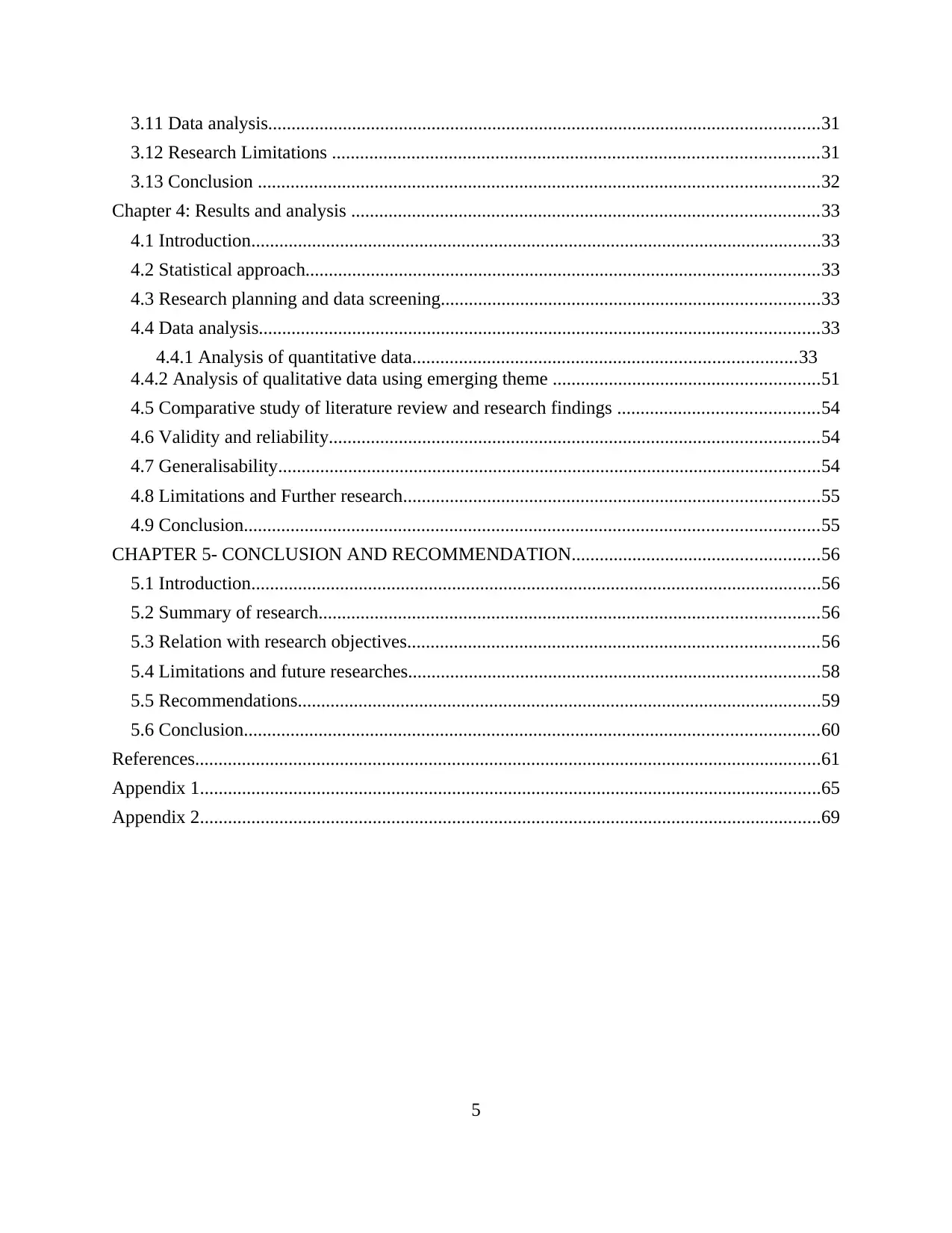
3.11 Data analysis......................................................................................................................31
3.12 Research Limitations ........................................................................................................31
3.13 Conclusion ........................................................................................................................32
Chapter 4: Results and analysis ....................................................................................................33
4.1 Introduction..........................................................................................................................33
4.2 Statistical approach..............................................................................................................33
4.3 Research planning and data screening.................................................................................33
4.4 Data analysis........................................................................................................................33
4.4.1 Analysis of quantitative data..................................................................................33
4.4.2 Analysis of qualitative data using emerging theme .........................................................51
4.5 Comparative study of literature review and research findings ...........................................54
4.6 Validity and reliability.........................................................................................................54
4.7 Generalisability....................................................................................................................54
4.8 Limitations and Further research.........................................................................................55
4.9 Conclusion...........................................................................................................................55
CHAPTER 5- CONCLUSION AND RECOMMENDATION.....................................................56
5.1 Introduction..........................................................................................................................56
5.2 Summary of research...........................................................................................................56
5.3 Relation with research objectives........................................................................................56
5.4 Limitations and future researches........................................................................................58
5.5 Recommendations................................................................................................................59
5.6 Conclusion...........................................................................................................................60
References......................................................................................................................................61
Appendix 1.....................................................................................................................................65
Appendix 2.....................................................................................................................................69
5
3.12 Research Limitations ........................................................................................................31
3.13 Conclusion ........................................................................................................................32
Chapter 4: Results and analysis ....................................................................................................33
4.1 Introduction..........................................................................................................................33
4.2 Statistical approach..............................................................................................................33
4.3 Research planning and data screening.................................................................................33
4.4 Data analysis........................................................................................................................33
4.4.1 Analysis of quantitative data..................................................................................33
4.4.2 Analysis of qualitative data using emerging theme .........................................................51
4.5 Comparative study of literature review and research findings ...........................................54
4.6 Validity and reliability.........................................................................................................54
4.7 Generalisability....................................................................................................................54
4.8 Limitations and Further research.........................................................................................55
4.9 Conclusion...........................................................................................................................55
CHAPTER 5- CONCLUSION AND RECOMMENDATION.....................................................56
5.1 Introduction..........................................................................................................................56
5.2 Summary of research...........................................................................................................56
5.3 Relation with research objectives........................................................................................56
5.4 Limitations and future researches........................................................................................58
5.5 Recommendations................................................................................................................59
5.6 Conclusion...........................................................................................................................60
References......................................................................................................................................61
Appendix 1.....................................................................................................................................65
Appendix 2.....................................................................................................................................69
5
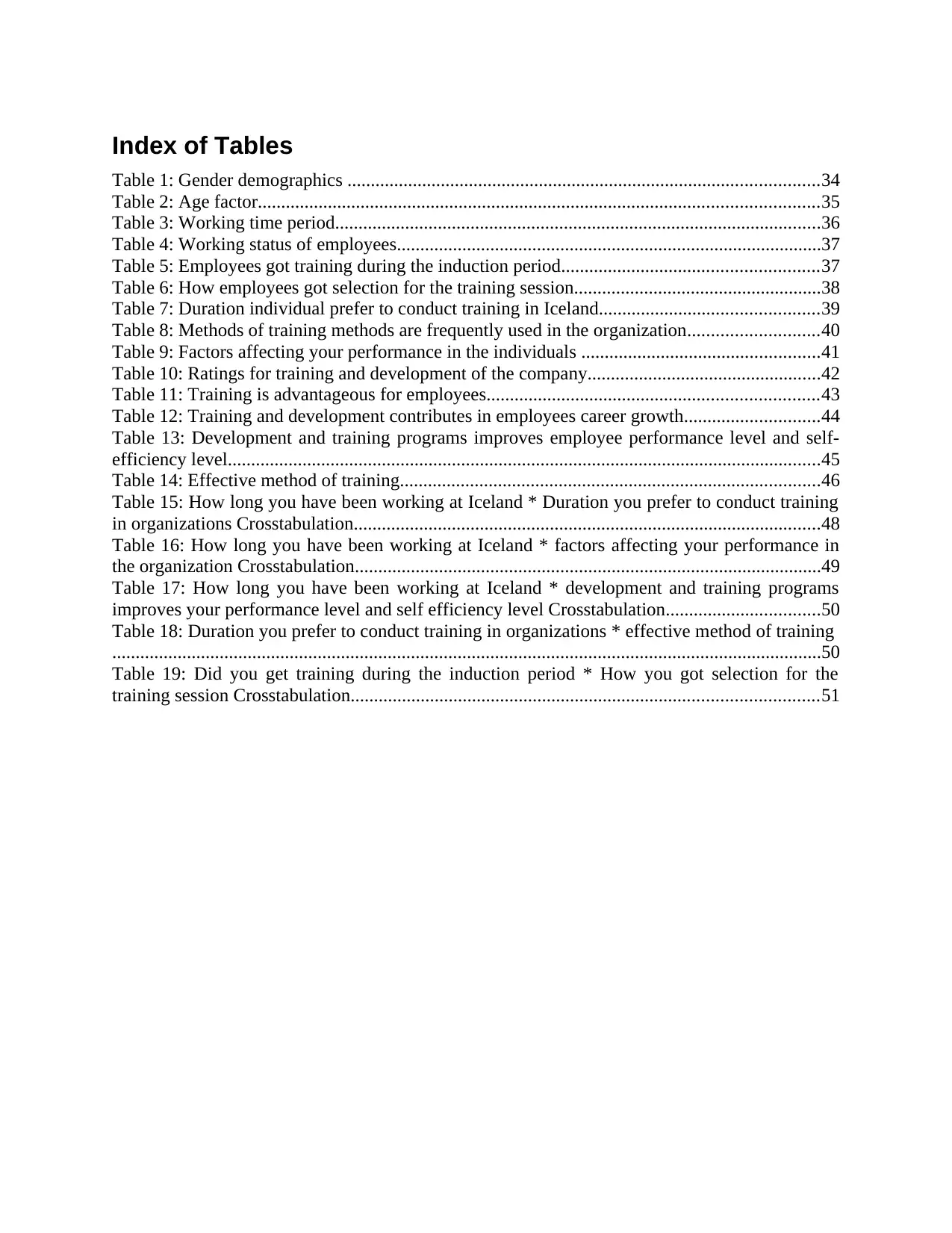
Index of Tables
Table 1: Gender demographics .....................................................................................................34
Table 2: Age factor........................................................................................................................35
Table 3: Working time period........................................................................................................36
Table 4: Working status of employees...........................................................................................37
Table 5: Employees got training during the induction period.......................................................37
Table 6: How employees got selection for the training session.....................................................38
Table 7: Duration individual prefer to conduct training in Iceland...............................................39
Table 8: Methods of training methods are frequently used in the organization............................40
Table 9: Factors affecting your performance in the individuals ...................................................41
Table 10: Ratings for training and development of the company..................................................42
Table 11: Training is advantageous for employees.......................................................................43
Table 12: Training and development contributes in employees career growth.............................44
Table 13: Development and training programs improves employee performance level and self-
efficiency level...............................................................................................................................45
Table 14: Effective method of training..........................................................................................46
Table 15: How long you have been working at Iceland * Duration you prefer to conduct training
in organizations Crosstabulation....................................................................................................48
Table 16: How long you have been working at Iceland * factors affecting your performance in
the organization Crosstabulation....................................................................................................49
Table 17: How long you have been working at Iceland * development and training programs
improves your performance level and self efficiency level Crosstabulation.................................50
Table 18: Duration you prefer to conduct training in organizations * effective method of training
........................................................................................................................................................50
Table 19: Did you get training during the induction period * How you got selection for the
training session Crosstabulation....................................................................................................51
Table 1: Gender demographics .....................................................................................................34
Table 2: Age factor........................................................................................................................35
Table 3: Working time period........................................................................................................36
Table 4: Working status of employees...........................................................................................37
Table 5: Employees got training during the induction period.......................................................37
Table 6: How employees got selection for the training session.....................................................38
Table 7: Duration individual prefer to conduct training in Iceland...............................................39
Table 8: Methods of training methods are frequently used in the organization............................40
Table 9: Factors affecting your performance in the individuals ...................................................41
Table 10: Ratings for training and development of the company..................................................42
Table 11: Training is advantageous for employees.......................................................................43
Table 12: Training and development contributes in employees career growth.............................44
Table 13: Development and training programs improves employee performance level and self-
efficiency level...............................................................................................................................45
Table 14: Effective method of training..........................................................................................46
Table 15: How long you have been working at Iceland * Duration you prefer to conduct training
in organizations Crosstabulation....................................................................................................48
Table 16: How long you have been working at Iceland * factors affecting your performance in
the organization Crosstabulation....................................................................................................49
Table 17: How long you have been working at Iceland * development and training programs
improves your performance level and self efficiency level Crosstabulation.................................50
Table 18: Duration you prefer to conduct training in organizations * effective method of training
........................................................................................................................................................50
Table 19: Did you get training during the induction period * How you got selection for the
training session Crosstabulation....................................................................................................51
⊘ This is a preview!⊘
Do you want full access?
Subscribe today to unlock all pages.

Trusted by 1+ million students worldwide

CHAPTER 1 INTRODUCTION
1.1 Introduction
Training and development plays vital role in the organization because it helps the
business organizations to enhance the effectiveness of employee performance which further
assists in achieving all the aims and objectives. The level of competition has been increasing in
the competitive world; thus employers are focusing more on employee performance and
efficiency level (Khandekar and Sharma, 2005). Training is regarded as an imperative
investment for the business entities which helps in getting prominent return for longer period.
1.1.1 Purpose
Training is essential for the purpose of eradicating all the loopholes and gaps prevailing
in the business and this also inspire the workforce to contribute more in organizational growth
and development. It is also concerned as significant function of human resource management
which aims to improve performance and productivity of the organization (Lucero and Allen,
2006). For human resource development, organizations have to ensure that developing activities
are properly implemented in the business and which is also working for workforce efficiency
enhancement. Training should always be organized according to the organizational aims and
objectives and that must match the industry standards.
1.1.2 Topic Area
The main area of the investigation is to research into the training methods and their
implications on employee performance. The aim of study is to find out the benefits of trainings
which is a core area of research, requires in-depth analysis of benefits of trainings for employee
performance, it terms of productivity, improving customer satisfaction in the retail industry.
However, the research is associated with the retail industry, hence, covered the theoretical
background of trainings and development. To increase the productivity, training are to be
imparted to the individuals, but, there is also a need to retain well trained and motivated
employees.
1.2 Research Background
1.2.1 Background
Iceland has been chosen as a case study because it is operating business on relatively
large scale; thus researcher has the possibility of collecting wide range of data. Apart from this,
1.1 Introduction
Training and development plays vital role in the organization because it helps the
business organizations to enhance the effectiveness of employee performance which further
assists in achieving all the aims and objectives. The level of competition has been increasing in
the competitive world; thus employers are focusing more on employee performance and
efficiency level (Khandekar and Sharma, 2005). Training is regarded as an imperative
investment for the business entities which helps in getting prominent return for longer period.
1.1.1 Purpose
Training is essential for the purpose of eradicating all the loopholes and gaps prevailing
in the business and this also inspire the workforce to contribute more in organizational growth
and development. It is also concerned as significant function of human resource management
which aims to improve performance and productivity of the organization (Lucero and Allen,
2006). For human resource development, organizations have to ensure that developing activities
are properly implemented in the business and which is also working for workforce efficiency
enhancement. Training should always be organized according to the organizational aims and
objectives and that must match the industry standards.
1.1.2 Topic Area
The main area of the investigation is to research into the training methods and their
implications on employee performance. The aim of study is to find out the benefits of trainings
which is a core area of research, requires in-depth analysis of benefits of trainings for employee
performance, it terms of productivity, improving customer satisfaction in the retail industry.
However, the research is associated with the retail industry, hence, covered the theoretical
background of trainings and development. To increase the productivity, training are to be
imparted to the individuals, but, there is also a need to retain well trained and motivated
employees.
1.2 Research Background
1.2.1 Background
Iceland has been chosen as a case study because it is operating business on relatively
large scale; thus researcher has the possibility of collecting wide range of data. Apart from this,
Paraphrase This Document
Need a fresh take? Get an instant paraphrase of this document with our AI Paraphraser
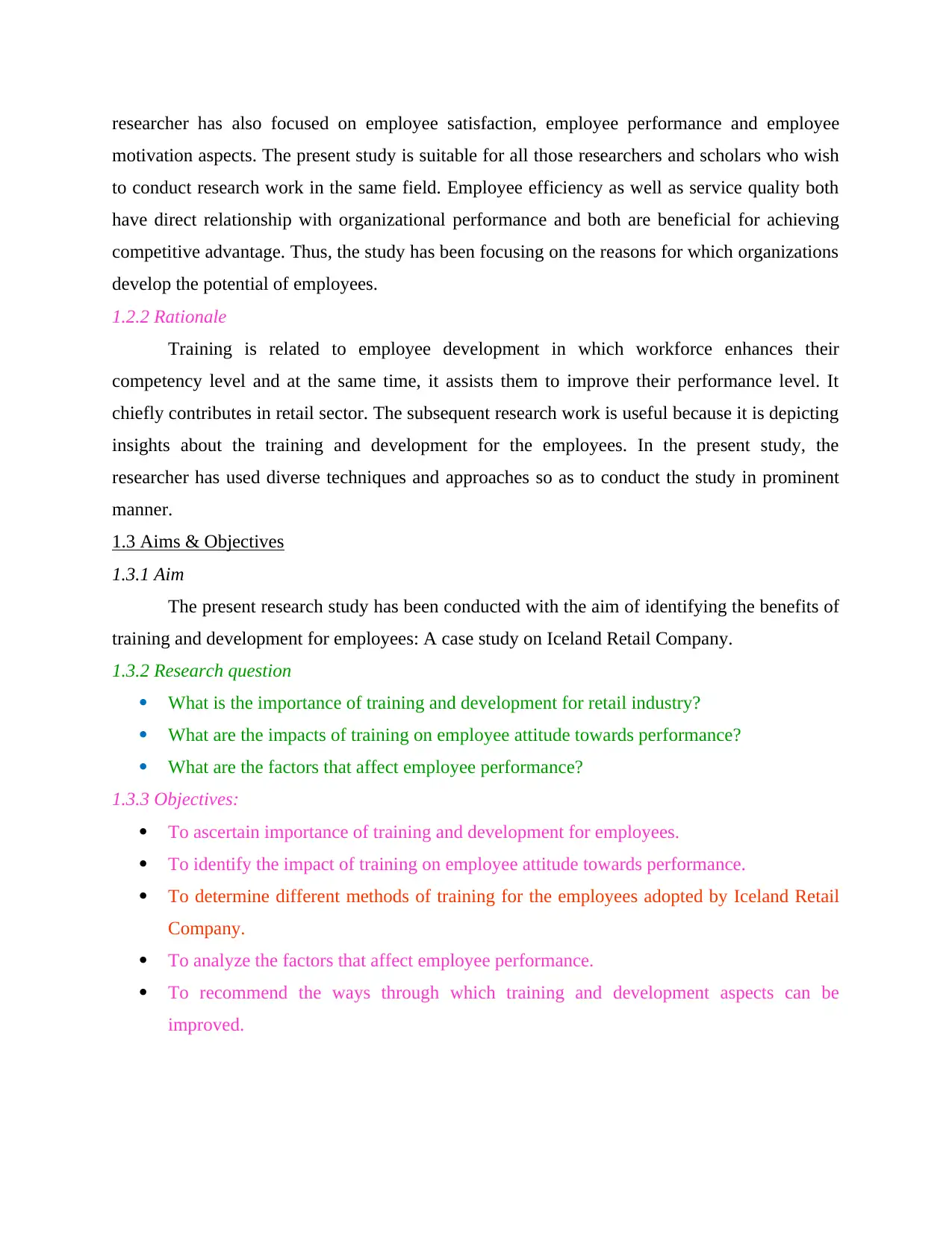
researcher has also focused on employee satisfaction, employee performance and employee
motivation aspects. The present study is suitable for all those researchers and scholars who wish
to conduct research work in the same field. Employee efficiency as well as service quality both
have direct relationship with organizational performance and both are beneficial for achieving
competitive advantage. Thus, the study has been focusing on the reasons for which organizations
develop the potential of employees.
1.2.2 Rationale
Training is related to employee development in which workforce enhances their
competency level and at the same time, it assists them to improve their performance level. It
chiefly contributes in retail sector. The subsequent research work is useful because it is depicting
insights about the training and development for the employees. In the present study, the
researcher has used diverse techniques and approaches so as to conduct the study in prominent
manner.
1.3 Aims & Objectives
1.3.1 Aim
The present research study has been conducted with the aim of identifying the benefits of
training and development for employees: A case study on Iceland Retail Company.
1.3.2 Research question
What is the importance of training and development for retail industry?
What are the impacts of training on employee attitude towards performance?
What are the factors that affect employee performance?
1.3.3 Objectives:
To ascertain importance of training and development for employees.
To identify the impact of training on employee attitude towards performance.
To determine different methods of training for the employees adopted by Iceland Retail
Company.
To analyze the factors that affect employee performance.
To recommend the ways through which training and development aspects can be
improved.
motivation aspects. The present study is suitable for all those researchers and scholars who wish
to conduct research work in the same field. Employee efficiency as well as service quality both
have direct relationship with organizational performance and both are beneficial for achieving
competitive advantage. Thus, the study has been focusing on the reasons for which organizations
develop the potential of employees.
1.2.2 Rationale
Training is related to employee development in which workforce enhances their
competency level and at the same time, it assists them to improve their performance level. It
chiefly contributes in retail sector. The subsequent research work is useful because it is depicting
insights about the training and development for the employees. In the present study, the
researcher has used diverse techniques and approaches so as to conduct the study in prominent
manner.
1.3 Aims & Objectives
1.3.1 Aim
The present research study has been conducted with the aim of identifying the benefits of
training and development for employees: A case study on Iceland Retail Company.
1.3.2 Research question
What is the importance of training and development for retail industry?
What are the impacts of training on employee attitude towards performance?
What are the factors that affect employee performance?
1.3.3 Objectives:
To ascertain importance of training and development for employees.
To identify the impact of training on employee attitude towards performance.
To determine different methods of training for the employees adopted by Iceland Retail
Company.
To analyze the factors that affect employee performance.
To recommend the ways through which training and development aspects can be
improved.

1.4 Structure of the research
The current research study has been attempted in a systematic structure and this also aids
in minimizing constraints and obstacles (Axinn and Pearce, 2006). At the time of attempting the
study, researcher has determined all the chapters that will be included in the research work.
Investigator has also given huge importance to the description of research questions and aims
and objectives so that the entire work can be completed in adequate manner. The most important
sections of the dissertation are literature review and research methodology which have been
completed in suitable manner. The format of the research study has been included in the below
mentioned section: Chapter 1 Introduction: This section has included background of the research topic
along with the rationale of the study (Marlow, 2010). Chapter 2 Literature Review: Literature review is prepared through secondary research
in which researcher uses research work of different authors and scholars. Literature
review shows that researcher has borrowed some work from other literature work.
Discussion is made regarding the subject matter and the entire section is completed
through critical writing. Chapter 3 Research Methodology: In research methodology, researcher uses different
methods and techniques so as to reach towards the aims and objectives (Crowther and
Lancaster, 2012). The section has included research philosophies, approaches, sampling,
ethical aspects and limitations. Chapter 4 Data Analysis: The section of data analysis plays crucial role in the research
study because herein, investigator evaluates the responses of respondents through
appropriate techniques (Daniel and Sam, 2011). Further, the software of SPSS is also
applied in the study so as to evaluate the responses in adequate manner.
Chapter 5 Conclusion and Recommendation: This is the last chapter of the research
study that summarizes the entire work along with the problems that have been observed
at the time of completing the study (Goddard and Melville, 2004).
The current research study has been attempted in a systematic structure and this also aids
in minimizing constraints and obstacles (Axinn and Pearce, 2006). At the time of attempting the
study, researcher has determined all the chapters that will be included in the research work.
Investigator has also given huge importance to the description of research questions and aims
and objectives so that the entire work can be completed in adequate manner. The most important
sections of the dissertation are literature review and research methodology which have been
completed in suitable manner. The format of the research study has been included in the below
mentioned section: Chapter 1 Introduction: This section has included background of the research topic
along with the rationale of the study (Marlow, 2010). Chapter 2 Literature Review: Literature review is prepared through secondary research
in which researcher uses research work of different authors and scholars. Literature
review shows that researcher has borrowed some work from other literature work.
Discussion is made regarding the subject matter and the entire section is completed
through critical writing. Chapter 3 Research Methodology: In research methodology, researcher uses different
methods and techniques so as to reach towards the aims and objectives (Crowther and
Lancaster, 2012). The section has included research philosophies, approaches, sampling,
ethical aspects and limitations. Chapter 4 Data Analysis: The section of data analysis plays crucial role in the research
study because herein, investigator evaluates the responses of respondents through
appropriate techniques (Daniel and Sam, 2011). Further, the software of SPSS is also
applied in the study so as to evaluate the responses in adequate manner.
Chapter 5 Conclusion and Recommendation: This is the last chapter of the research
study that summarizes the entire work along with the problems that have been observed
at the time of completing the study (Goddard and Melville, 2004).
⊘ This is a preview!⊘
Do you want full access?
Subscribe today to unlock all pages.

Trusted by 1+ million students worldwide
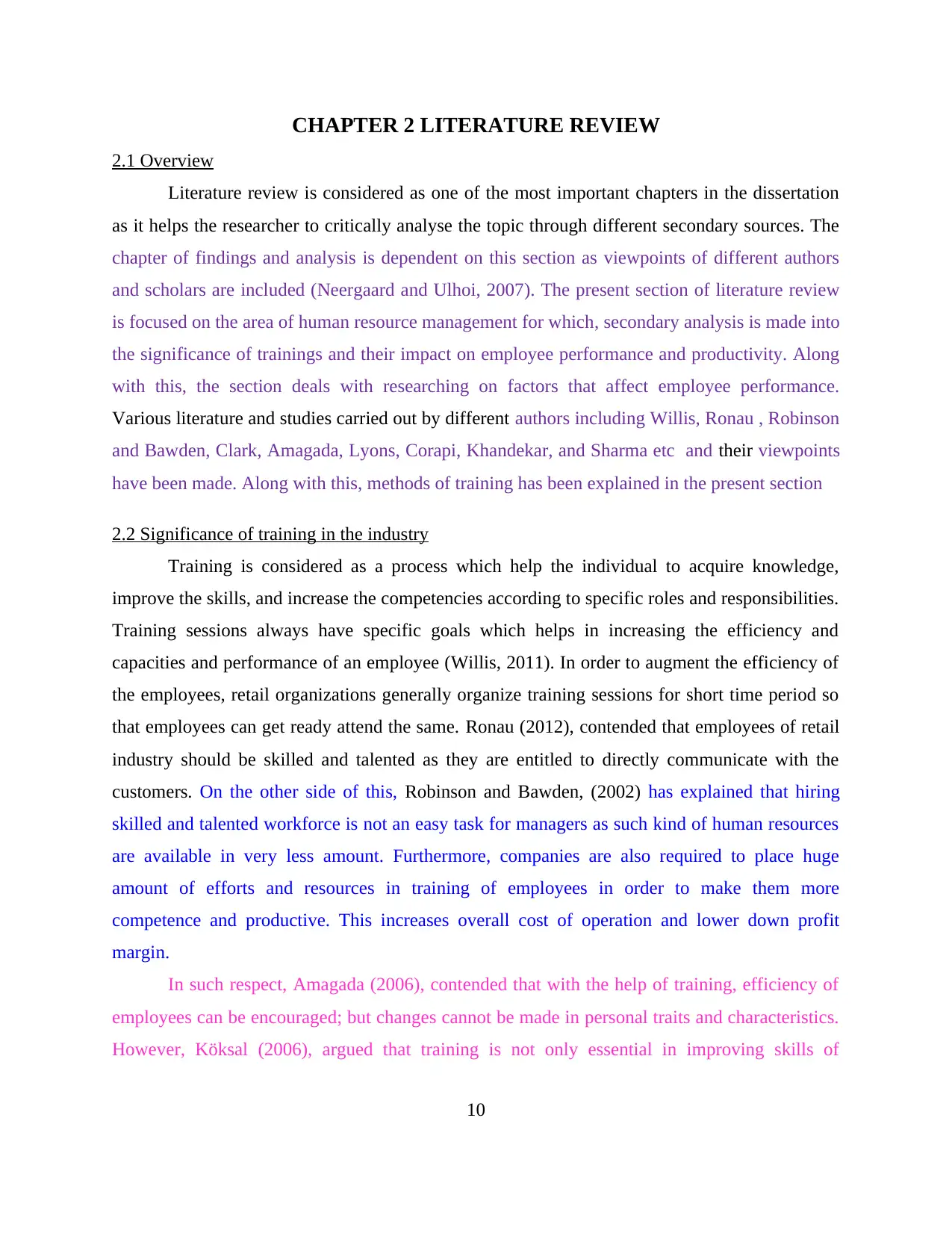
CHAPTER 2 LITERATURE REVIEW
2.1 Overview
Literature review is considered as one of the most important chapters in the dissertation
as it helps the researcher to critically analyse the topic through different secondary sources. The
chapter of findings and analysis is dependent on this section as viewpoints of different authors
and scholars are included (Neergaard and Ulhoi, 2007). The present section of literature review
is focused on the area of human resource management for which, secondary analysis is made into
the significance of trainings and their impact on employee performance and productivity. Along
with this, the section deals with researching on factors that affect employee performance.
Various literature and studies carried out by different authors including Willis, Ronau , Robinson
and Bawden, Clark, Amagada, Lyons, Corapi, Khandekar, and Sharma etc and their viewpoints
have been made. Along with this, methods of training has been explained in the present section
2.2 Significance of training in the industry
Training is considered as a process which help the individual to acquire knowledge,
improve the skills, and increase the competencies according to specific roles and responsibilities.
Training sessions always have specific goals which helps in increasing the efficiency and
capacities and performance of an employee (Willis, 2011). In order to augment the efficiency of
the employees, retail organizations generally organize training sessions for short time period so
that employees can get ready attend the same. Ronau (2012), contended that employees of retail
industry should be skilled and talented as they are entitled to directly communicate with the
customers. On the other side of this, Robinson and Bawden, (2002) has explained that hiring
skilled and talented workforce is not an easy task for managers as such kind of human resources
are available in very less amount. Furthermore, companies are also required to place huge
amount of efforts and resources in training of employees in order to make them more
competence and productive. This increases overall cost of operation and lower down profit
margin.
In such respect, Amagada (2006), contended that with the help of training, efficiency of
employees can be encouraged; but changes cannot be made in personal traits and characteristics.
However, Köksal (2006), argued that training is not only essential in improving skills of
10
2.1 Overview
Literature review is considered as one of the most important chapters in the dissertation
as it helps the researcher to critically analyse the topic through different secondary sources. The
chapter of findings and analysis is dependent on this section as viewpoints of different authors
and scholars are included (Neergaard and Ulhoi, 2007). The present section of literature review
is focused on the area of human resource management for which, secondary analysis is made into
the significance of trainings and their impact on employee performance and productivity. Along
with this, the section deals with researching on factors that affect employee performance.
Various literature and studies carried out by different authors including Willis, Ronau , Robinson
and Bawden, Clark, Amagada, Lyons, Corapi, Khandekar, and Sharma etc and their viewpoints
have been made. Along with this, methods of training has been explained in the present section
2.2 Significance of training in the industry
Training is considered as a process which help the individual to acquire knowledge,
improve the skills, and increase the competencies according to specific roles and responsibilities.
Training sessions always have specific goals which helps in increasing the efficiency and
capacities and performance of an employee (Willis, 2011). In order to augment the efficiency of
the employees, retail organizations generally organize training sessions for short time period so
that employees can get ready attend the same. Ronau (2012), contended that employees of retail
industry should be skilled and talented as they are entitled to directly communicate with the
customers. On the other side of this, Robinson and Bawden, (2002) has explained that hiring
skilled and talented workforce is not an easy task for managers as such kind of human resources
are available in very less amount. Furthermore, companies are also required to place huge
amount of efforts and resources in training of employees in order to make them more
competence and productive. This increases overall cost of operation and lower down profit
margin.
In such respect, Amagada (2006), contended that with the help of training, efficiency of
employees can be encouraged; but changes cannot be made in personal traits and characteristics.
However, Köksal (2006), argued that training is not only essential in improving skills of
10
Paraphrase This Document
Need a fresh take? Get an instant paraphrase of this document with our AI Paraphraser
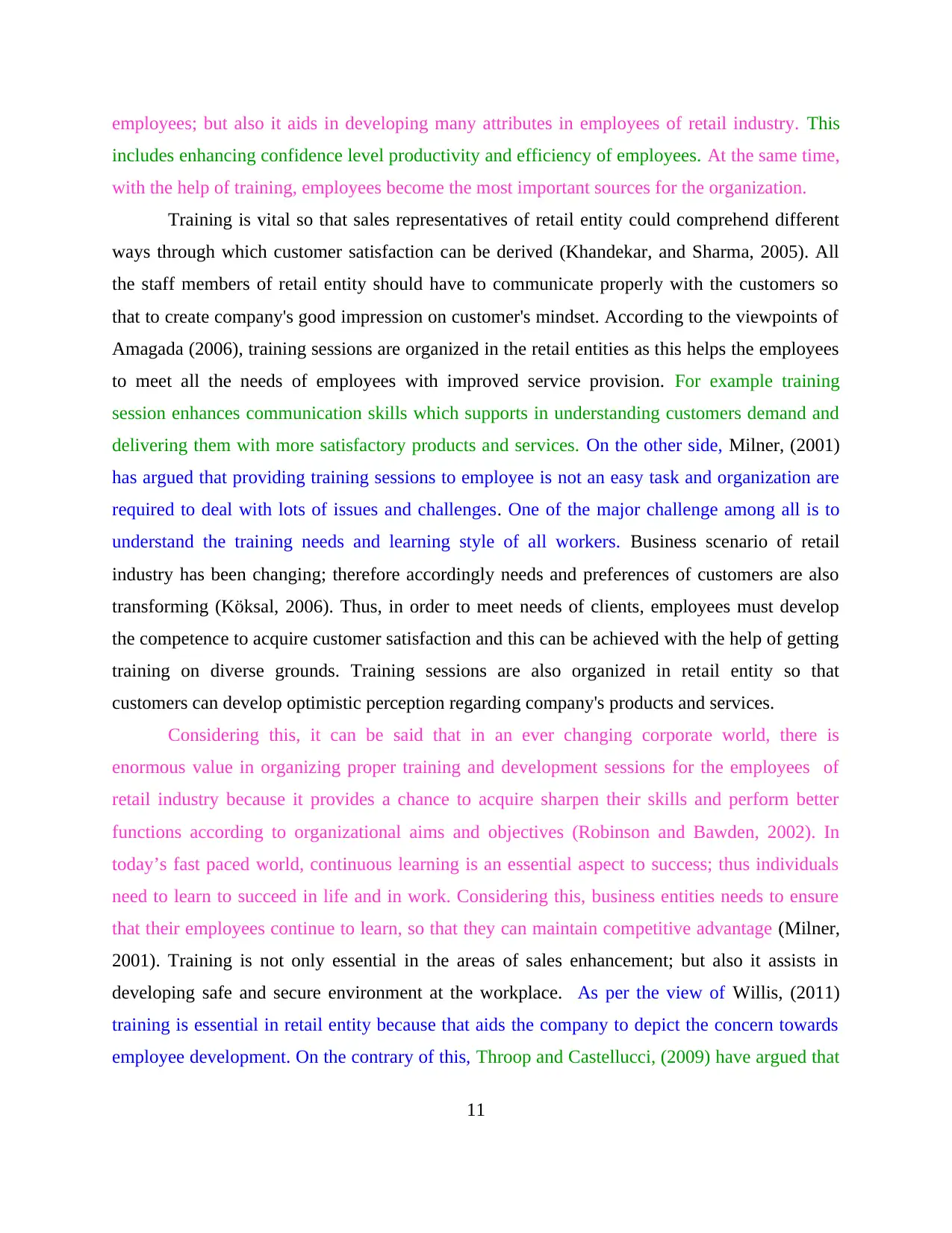
employees; but also it aids in developing many attributes in employees of retail industry. This
includes enhancing confidence level productivity and efficiency of employees. At the same time,
with the help of training, employees become the most important sources for the organization.
Training is vital so that sales representatives of retail entity could comprehend different
ways through which customer satisfaction can be derived (Khandekar, and Sharma, 2005). All
the staff members of retail entity should have to communicate properly with the customers so
that to create company's good impression on customer's mindset. According to the viewpoints of
Amagada (2006), training sessions are organized in the retail entities as this helps the employees
to meet all the needs of employees with improved service provision. For example training
session enhances communication skills which supports in understanding customers demand and
delivering them with more satisfactory products and services. On the other side, Milner, (2001)
has argued that providing training sessions to employee is not an easy task and organization are
required to deal with lots of issues and challenges. One of the major challenge among all is to
understand the training needs and learning style of all workers. Business scenario of retail
industry has been changing; therefore accordingly needs and preferences of customers are also
transforming (Köksal, 2006). Thus, in order to meet needs of clients, employees must develop
the competence to acquire customer satisfaction and this can be achieved with the help of getting
training on diverse grounds. Training sessions are also organized in retail entity so that
customers can develop optimistic perception regarding company's products and services.
Considering this, it can be said that in an ever changing corporate world, there is
enormous value in organizing proper training and development sessions for the employees of
retail industry because it provides a chance to acquire sharpen their skills and perform better
functions according to organizational aims and objectives (Robinson and Bawden, 2002). In
today’s fast paced world, continuous learning is an essential aspect to success; thus individuals
need to learn to succeed in life and in work. Considering this, business entities needs to ensure
that their employees continue to learn, so that they can maintain competitive advantage (Milner,
2001). Training is not only essential in the areas of sales enhancement; but also it assists in
developing safe and secure environment at the workplace. As per the view of Willis, (2011)
training is essential in retail entity because that aids the company to depict the concern towards
employee development. On the contrary of this, Throop and Castellucci, (2009) have argued that
11
includes enhancing confidence level productivity and efficiency of employees. At the same time,
with the help of training, employees become the most important sources for the organization.
Training is vital so that sales representatives of retail entity could comprehend different
ways through which customer satisfaction can be derived (Khandekar, and Sharma, 2005). All
the staff members of retail entity should have to communicate properly with the customers so
that to create company's good impression on customer's mindset. According to the viewpoints of
Amagada (2006), training sessions are organized in the retail entities as this helps the employees
to meet all the needs of employees with improved service provision. For example training
session enhances communication skills which supports in understanding customers demand and
delivering them with more satisfactory products and services. On the other side, Milner, (2001)
has argued that providing training sessions to employee is not an easy task and organization are
required to deal with lots of issues and challenges. One of the major challenge among all is to
understand the training needs and learning style of all workers. Business scenario of retail
industry has been changing; therefore accordingly needs and preferences of customers are also
transforming (Köksal, 2006). Thus, in order to meet needs of clients, employees must develop
the competence to acquire customer satisfaction and this can be achieved with the help of getting
training on diverse grounds. Training sessions are also organized in retail entity so that
customers can develop optimistic perception regarding company's products and services.
Considering this, it can be said that in an ever changing corporate world, there is
enormous value in organizing proper training and development sessions for the employees of
retail industry because it provides a chance to acquire sharpen their skills and perform better
functions according to organizational aims and objectives (Robinson and Bawden, 2002). In
today’s fast paced world, continuous learning is an essential aspect to success; thus individuals
need to learn to succeed in life and in work. Considering this, business entities needs to ensure
that their employees continue to learn, so that they can maintain competitive advantage (Milner,
2001). Training is not only essential in the areas of sales enhancement; but also it assists in
developing safe and secure environment at the workplace. As per the view of Willis, (2011)
training is essential in retail entity because that aids the company to depict the concern towards
employee development. On the contrary of this, Throop and Castellucci, (2009) have argued that
11
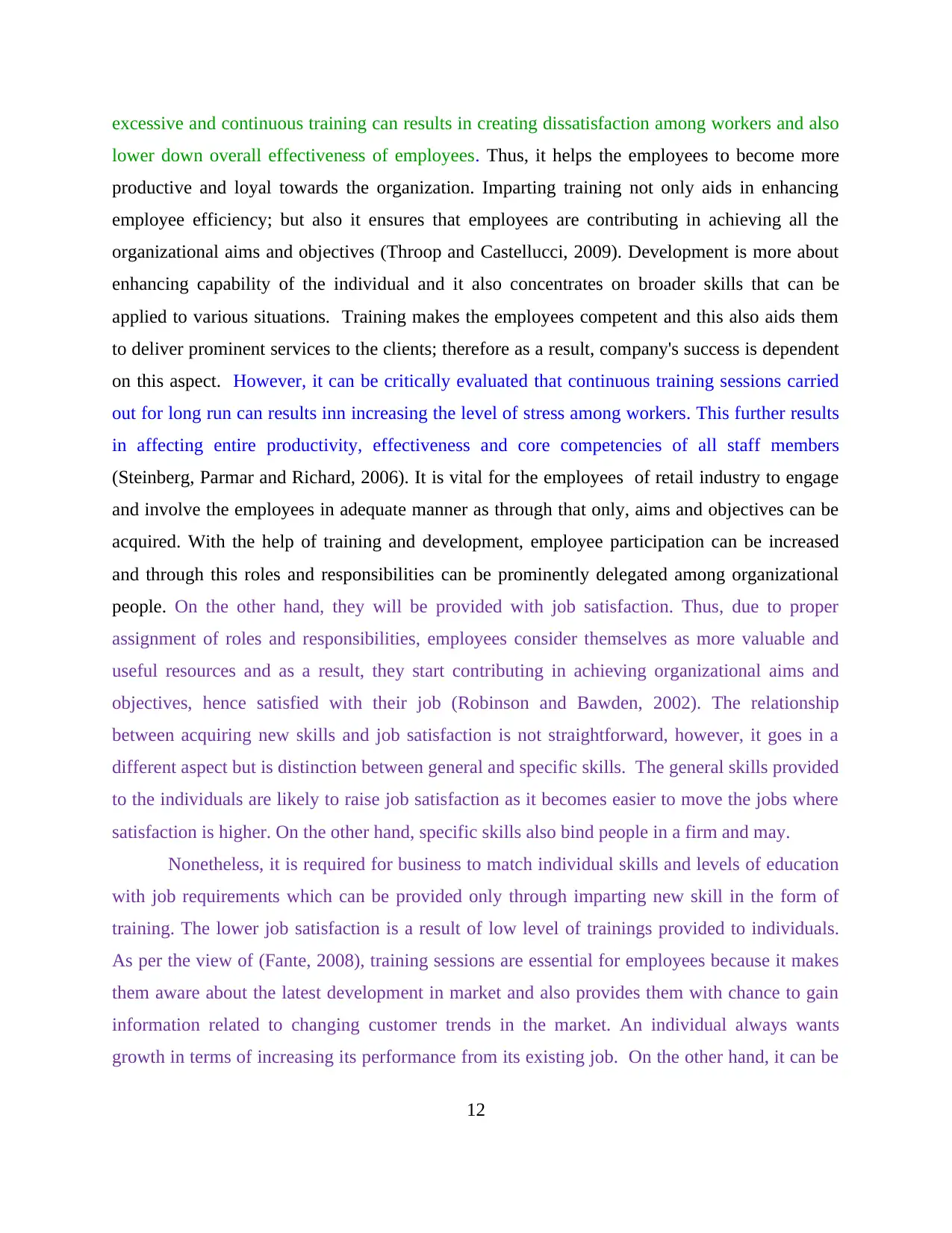
excessive and continuous training can results in creating dissatisfaction among workers and also
lower down overall effectiveness of employees. Thus, it helps the employees to become more
productive and loyal towards the organization. Imparting training not only aids in enhancing
employee efficiency; but also it ensures that employees are contributing in achieving all the
organizational aims and objectives (Throop and Castellucci, 2009). Development is more about
enhancing capability of the individual and it also concentrates on broader skills that can be
applied to various situations. Training makes the employees competent and this also aids them
to deliver prominent services to the clients; therefore as a result, company's success is dependent
on this aspect. However, it can be critically evaluated that continuous training sessions carried
out for long run can results inn increasing the level of stress among workers. This further results
in affecting entire productivity, effectiveness and core competencies of all staff members
(Steinberg, Parmar and Richard, 2006). It is vital for the employees of retail industry to engage
and involve the employees in adequate manner as through that only, aims and objectives can be
acquired. With the help of training and development, employee participation can be increased
and through this roles and responsibilities can be prominently delegated among organizational
people. On the other hand, they will be provided with job satisfaction. Thus, due to proper
assignment of roles and responsibilities, employees consider themselves as more valuable and
useful resources and as a result, they start contributing in achieving organizational aims and
objectives, hence satisfied with their job (Robinson and Bawden, 2002). The relationship
between acquiring new skills and job satisfaction is not straightforward, however, it goes in a
different aspect but is distinction between general and specific skills. The general skills provided
to the individuals are likely to raise job satisfaction as it becomes easier to move the jobs where
satisfaction is higher. On the other hand, specific skills also bind people in a firm and may.
Nonetheless, it is required for business to match individual skills and levels of education
with job requirements which can be provided only through imparting new skill in the form of
training. The lower job satisfaction is a result of low level of trainings provided to individuals.
As per the view of (Fante, 2008), training sessions are essential for employees because it makes
them aware about the latest development in market and also provides them with chance to gain
information related to changing customer trends in the market. An individual always wants
growth in terms of increasing its performance from its existing job. On the other hand, it can be
12
lower down overall effectiveness of employees. Thus, it helps the employees to become more
productive and loyal towards the organization. Imparting training not only aids in enhancing
employee efficiency; but also it ensures that employees are contributing in achieving all the
organizational aims and objectives (Throop and Castellucci, 2009). Development is more about
enhancing capability of the individual and it also concentrates on broader skills that can be
applied to various situations. Training makes the employees competent and this also aids them
to deliver prominent services to the clients; therefore as a result, company's success is dependent
on this aspect. However, it can be critically evaluated that continuous training sessions carried
out for long run can results inn increasing the level of stress among workers. This further results
in affecting entire productivity, effectiveness and core competencies of all staff members
(Steinberg, Parmar and Richard, 2006). It is vital for the employees of retail industry to engage
and involve the employees in adequate manner as through that only, aims and objectives can be
acquired. With the help of training and development, employee participation can be increased
and through this roles and responsibilities can be prominently delegated among organizational
people. On the other hand, they will be provided with job satisfaction. Thus, due to proper
assignment of roles and responsibilities, employees consider themselves as more valuable and
useful resources and as a result, they start contributing in achieving organizational aims and
objectives, hence satisfied with their job (Robinson and Bawden, 2002). The relationship
between acquiring new skills and job satisfaction is not straightforward, however, it goes in a
different aspect but is distinction between general and specific skills. The general skills provided
to the individuals are likely to raise job satisfaction as it becomes easier to move the jobs where
satisfaction is higher. On the other hand, specific skills also bind people in a firm and may.
Nonetheless, it is required for business to match individual skills and levels of education
with job requirements which can be provided only through imparting new skill in the form of
training. The lower job satisfaction is a result of low level of trainings provided to individuals.
As per the view of (Fante, 2008), training sessions are essential for employees because it makes
them aware about the latest development in market and also provides them with chance to gain
information related to changing customer trends in the market. An individual always wants
growth in terms of increasing its performance from its existing job. On the other hand, it can be
12
⊘ This is a preview!⊘
Do you want full access?
Subscribe today to unlock all pages.

Trusted by 1+ million students worldwide
1 out of 71
Related Documents
Your All-in-One AI-Powered Toolkit for Academic Success.
+13062052269
info@desklib.com
Available 24*7 on WhatsApp / Email
![[object Object]](/_next/static/media/star-bottom.7253800d.svg)
Unlock your academic potential
Copyright © 2020–2025 A2Z Services. All Rights Reserved. Developed and managed by ZUCOL.





